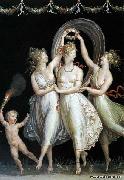Wholesale Oil Painting No Minimum |
|||||||||||
|
|
|||||||||||

|
|||||||||||
|
|
|
||||||||
Antonio CanovaItalian Neoclassical Sculptor, 1757-1822 Italian sculptor, painter, draughtsman and architect. He was the most innovative and widely acclaimed sculptor of NEO-CLASSICISM. His development during the 1780s of a new style of revolutionary severity and idealistic purity led many of his contemporaries to prefer his ideal sculptures to such previously universally admired Antique statues as the Medici Venus and the Farnese Hercules, thus greatly increasing the prestige of 'modern' sculpture. He was also much in demand as a portrait sculptor. |
||||||||
|
|
||||||||
The Three Graces Dancing
The Three Graces Dancing Painting ID:: 62546 |
1799 Tempera on paper Canova Museum, Possagna Canova mentioned "various ideas on dances, the play between nymphs and cupids, muses, philosophers, etc., sketched exclusively for the artist's own study and enjoyment." There is little doubt he was referring to the tempera cycle at Possagno and similar sketches now in Bassano. Picking up the themes and techniques discovered in Herculaneum, Canova created brightly coloured mythological figures that stand out against the black background. These sketches are the forerunners of themes and figures he would later sculpt. The picture shows a detail from a frieze. Author: CANOVA, Antonio Title: The Three Graces Dancing Form: graphics , 1751-1800 , Italian , mythological 1799 Tempera on paper Canova Museum, Possagna Canova mentioned "various ideas on dances, the play between nymphs and cupids, muses, philosophers, etc., sketched exclusively for the artist's own study and enjoyment." There is little doubt he was referring to the tempera cycle at Possagno and similar sketches now in Bassano. Picking up the themes and techniques discovered in Herculaneum, Canova created brightly coloured mythological figures that stand out against the black background. These sketches are the forerunners of themes and figures he would later sculpt. The picture shows a detail from a frieze. Author: CANOVA, Antonio Title: The Three Graces Dancing Form: graphics , 1751-1800 , Italian , mythological |
|||||||
|
CONTACT US |

